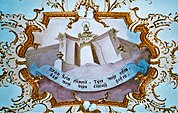Pearly gates

Pearly gates is an informal name for the gateway to Heaven according to some Christian denominations. It is inspired by the description of the New Jerusalem in Revelation 21:21: "The twelve gates were twelve pearls, each gate being made from a single pearl."[1]
The image of the gates in popular culture is a set of large gold, white or wrought-iron gates in the clouds, guarded by Saint Peter (the keeper of the "keys to the kingdom"). Those not fit to enter heaven are denied entrance at the gates, and descend into Hell.[2] In some versions of this imagery, Peter looks up the deceased's name in a book, before opening the gate.
The Book of Mormon teaches that there is no "keeper of the gate" 2 Nephi 9:41 "O then, my beloved brethren, come unto the Lord, the Holy One. Remember that his paths are righteous. Behold, the way for man is narrow, but it lieth in a straight course before him, and the keeper of the gate is the Holy One of Israel; and he employeth no servant there; and there is none other way save it be by the gate; for he cannot be deceived, for the Lord God is his name."
References[]
- ^ Lang, J. Stephen (2003). "59: Imagine the Size of Those Oysters". What the Good Book Didn't Say: Popular Myths and Misconceptions About the Bible. Citadel Press. p. 185. ISBN 9780806524603.
- ^ Ferguson, Everett (1996). The Church of Christ: A Biblical Ecclesiology for Today. Wm. B. Eerdmans Publishing. p. 53. ISBN 9780802841896.
The passage moves from a building, to gates, to keys. A popular image has Peter as the doorkeeper of heaven, deciding admission through the pearly gates to each person at death. This understanding of Peter goes back to an early medieval interpretation that identified Peter with a figure in Germanic mythology who was the porter of heaven.
- Heaven in Christianity
- Christian mythology
- Christian terminology
- Book of Revelation
- Pearls
- Christianity stubs

